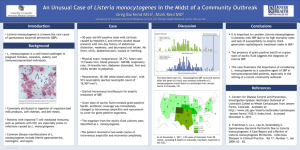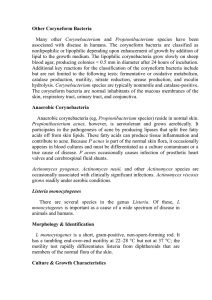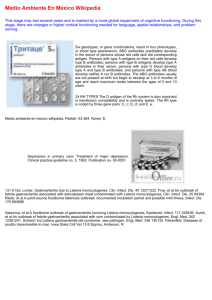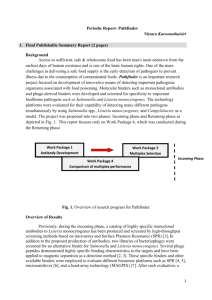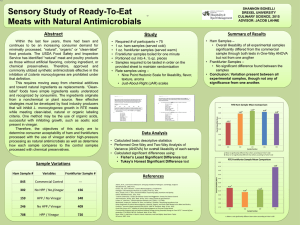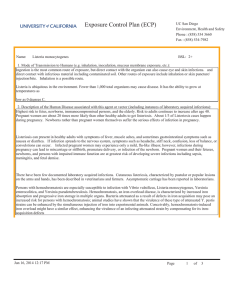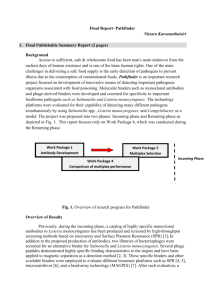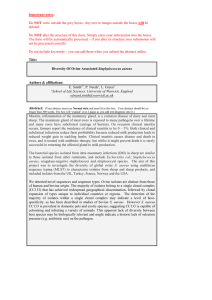GAMIDI Kimon Andreas Karatzas
advertisement
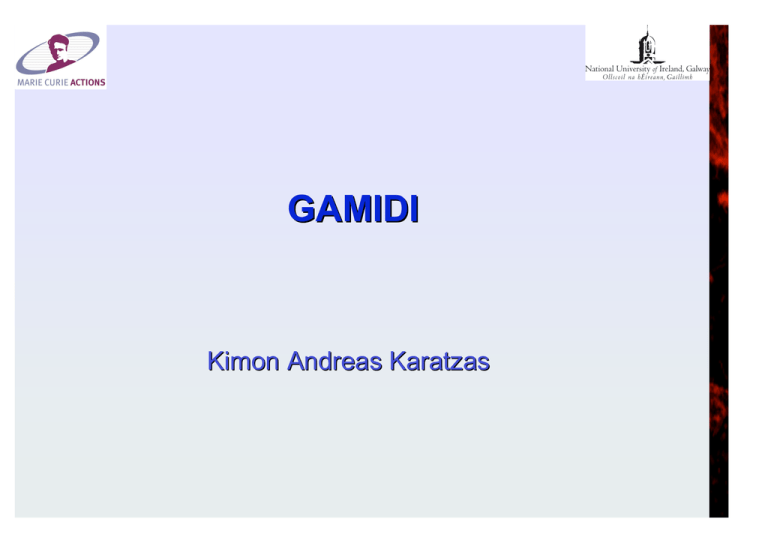
GAMIDI Kimon Andreas Karatzas Listeria monocytogenes • • • • • • Gram positive Facultative anaerobic Motile Foodborne pathogen Causes listeriosis (0.02% of food-related diseases) High fatality rate (28%) between immunocompromised individuals • 10% of food-borne-related deaths in the US Genes under investigation • Lmo0913: Succinate semialdehyde dehydrogenase (Acid tolerance) • Lmo0796: Homology to TT1927b of Thermus thermophilus HB8 possibly involved in C40 isoprenoid transport or/and storage or metabolism (Acid tolerance) • Lmo2391:?????(Acid tolerance) • Lmo2748: contains motif for Pyridoxamine 5'-phosphate oxidase (Osmotolerance) • Started complementation of the mutants Invasiveness of mutants • Invasiveness of ΔsigB was lower than the WT 0.6 0.5 • Invasiveness of all mutants was higher than WT % invasion 0.4 0.3 0.2 0.1 w t 0 Strain • Collaboration with Dr. Aiofe Boyd and Ksenia Matlawska-Wasowska • Invasiveness of Δlmo0913 was the highest (5-fold higher than the WT) Roles of glutamate and GABA glutamate γ-amino butyric acid (GABA) GadC glutamate H+ Succinate semialdehyde Lmo913 GadA GadB γ-amino butyric acid (GABA) Succinate GABAase assay • Δlmo0913 showed lower GABA concentrations 0.25 0.24 0.23 0.22 Od 340 0.21 wt average 0.2 913 ave SigB ave 0.19 • Differences were not statistically significant 0.18 0.17 0.16 0.15 0 20 40 60 80 time (min) 100 120 140 • GABAase assay should be performed under conditions that Δlmo0913 is induced Future work • Investigation of role of PLP (active vitamin B6) in combination with Lmo2748 (Pyridoxamine 5'phosphate oxidase) • Overexpression of all genes that were mutated • Investigation of increased invasiveness of Lmo0913 Experience • • • • • Proteomics (protein 2D gel electrophoresis) Functional genomics in Gram+ and GramTranscriptomics (RT PCR) High Pressure technology Antimicrobial resistance (contribution of disinfectants to antibiotic resistance) • Stress resistance of bacteria Thank you Isolation of piezotolerant strains of L. monocytogenes Growth in BHI until exponential phase (30oC) Determination of piezotolerance of isolates Incubation at 37oC Plating on BHI agar plates HHP treatment 350 MPa (20 min) Isolation of individual colonies Listeria monocytogenes Pure culture of L. monocytogenes 6 Wt 4 2 AK01 0 100 200 300 400 Pressure (MPa) Listeria monocytogenes Log reduction AK01: A piezotolerant L. monocytogenes mutant Increased thermotolerance of AK01 at 55oC 9 7 AK01 (heat) 5 Wt AK01 3 0 10 Tim e (m in) 20 Listeria monocytogenes Log (cfu ml -1 ) Wt (heat) Phenotype of AK01 Wt Wt AK01 AK01 Listeria monocytogenes Impaired growth and formation of small colonies Reduced virulence of AK01 6 Wt 5 4 3 < AK01 2 0 1 2 Time (Days) 3 Listeria monocytogenes Log (cfu spleen-1) 7 Morphology of AK01 Immobility and increased cell size Wild type AK01 Listeria monocytogenes Altered protein expression in AK01 AK01 pI gradient Mw pH 4 pH 6 pH4 pH6 29.0 18.4 FlaA FlaA ClpP ClpP Wt AK01 14.3 • Decreased FlaA (immobility) Listeria monocytogenes 43.0 • Increased ClpP (stress resistance) A mutation in the ctsR gene of AK01 • ctsR (class three stress gene repressor) • MB18: insertion of the mut ctsR gene 1. Increased piezotolerance (ClpP) 2. Immobility (FlaA) Listeria monocytogenes • Mutation in ctsR responsible for: Mutation in ctsR of AK01 Ser Lys Arg Gly Gly Gly Gly Wt: AGT AAA CGT GGT GGT GGT GGC Ser Lys Arg Gly Gly Gly In ΑΚ01 the CtsR protein contains a glycine less than in the Wt Listeria monocytogenes ΑΚ01: AGT AAA C . . . GT GGT GGT GGC Role of ctsR ctsR lmo0230 lmo0231 clpC CtsR Repression of clpB, clpP, clpE • Clps form complexes (essential for heat shock response) • ClpP (proteolytic subunit) • ctsR is an economy mechanism by repressing expression of heat shock proteins Listeria monocytogenes Autorepression Was isolation of AK01 a rare incident? • HHP experiments were performed and isolates were analyzed Listeria monocytogenes • Experiments performed in triplicate • Growth temperature: 30oC • HHP applied on pure cultures at exponential phase • 350 MPa for 20 min • Randomly selected 28 Isolates each time ~30% of isolates were piezotolerant 7 6 5 4 3 2 1 0 Wt AK 1 2 3 4 5 6 7 8 9 10 11 12 13 14 15 16 17 18 19 20 21 22 23 24 25 26 27 28 Isolates Listeria monocytogenes -1 log reduction (cfu ml ) 8 High frequency of mutations in ctsR between piezotolerant isolates Listeria monocytogenes Increased frequency of piezotolerant mutants • 0.06% of cells in a Wt population are piezotolerant (exponential phase) • The occurrence of AK01 and other piezotolerant isolates in a wild type population of L. monocytogenes Scott A is a common phenomenon with stable frequency Listeria monocytogenes • 66% of the piezotolerant isolates contained the ctsR mutation The glycine-rich region of ctsR is a Short Sequence Repeat (SSR) region Listeria monocytogenes • SSRs are hypermutable • Mechanism: DNA polymerase slippage • Molecular studies in Saccharomyces cerevisiae have shown that poly(G-T) tracts are extremely unstable, with length alterations occurring at a frequency of at least 10-4 event per cellular division (Henderson, S. T., and T. D. Petes. 1992). The role of SSRs Listeria monocytogenes • The SSR of ctsR is a part of a strategy for the increased production of stress tolerant mutants within populations of L. monocytogenes • SSRs are overepresented in stress genes (Rocha et al. 2002) • Through SSRs, variability within a population becomes an inherited characteristic and does not rely on the extremely rare occurrence of an advantageous random mutation Conclusions • Discovery of a piezotolerant mutant of L. monocytogenes (AK01) with multiple stress resistance (HHP, heat, acid) • A mutation in the ctsR gene of AK01 responsible for its phenotype • The mutation is in a hypermutable region resulting in variability within the population Listeria monocytogenes • Immobility and reduced virulence of AK01 Does the SSR of ctsR plays a role in stress tolerance of other bacteria? • S. aureus contains 4 repeats in the glycine rich region higher frequency of mutagenic events? Listeria monocytogenes • S. aureus • Gram positive • Non motile, coccus • Natural part of human microflora • Leading cause of nosocomial infections • Increased antibiotic resistance (MRSA) Staphylococcus aureus • Foodborne pathogen: production of thermostable toxin In search for piezotolerant isolates of S. aureus • Isolation of a pure culture • HHP of 400 MPa for 30 min • Investigation of isolates Staphylococcus aureus • Growth for 5 days at 37oC (subculturing every day following overnight incubation) Piezotolerant variants form small colonies Staphylococcus aureus 2 1.5 • Small colony variants 1 0.5 0 -0.5 -1 -1.5 1 2 3 4 5 6 7 8 9 10 11 12 13 14 15 16 17 18 19 20 21 Isolate number • Wild type Staphylococcus aureus Wt log reduction (cfu ml-1) – isolate log reduction (CFU ml-1) Isolation of piezotolerant variants 3 2 1 0 1 2 3 4 5 6 7 8 9 1 01 11 21 31 41 51 61 71 81 92 02 1 -1 -2 -3 -4 -5 Isolate number • Small colony variants • Wild type Staphylococcus aureus Wt log reduction (cfu ml-1) – isolate log reduction (CFU ml-1) Increased thermotolerance of piezotolerant variants Piezotolerant S. aureus variants are less invasive 10 8 7 6 5 4 WT 3 8 9 13 20 21 Isolate number S. aureus can: 1. invade Caco-2 cells 2. colonise the intestinal tract, even causing enteritidis 3. be protected from antibiotic treatment while being inside the host cells Staphylococcus aureus Log (CFU ml-1) 9 • Invasion was assessed in Caco-2 cells following the gentamicin protection assay Piezotolerant S. aureus variants are more susceptible to antibiotics Amikacin 30 Kanamycin 30 Oxacillin 1 Neomycin 10 Gentamycin 10 Furazolidone 100 WT 15 R 15 I 16 R 13 R 17 R 17 1 18 I 18 21 16 R 21 17 20 15 R 18 18 13 R 17 R 17 21 20 20 21 18 21 18 Zones of inhibition were greater for the piezotolerant variants Staphylococcus aureus Isolate Genomic indexing (microarrays) was performed for isolate 21 and the Wt Staphylococcus aureus • Genes SAR0666 – SAR0673 showed no hybridization in isolate 21 in contrast to the Wt Sequencing reveals the mutation in isolate 21 SAR0664 SAR0665 SAR0666 SAR0667 SAR0668 SAR0669 SAR0670 SAR0671 SAR0672 SAR0673 SAR0674 ATTGCGGGTG ATTGCGGGTG SAR0665 SAR0675 ATTGCGGGTG • The deletion covers 9351 bp and 10 genes • Mutation was present in all piezotolerant isolates Staphylococcus aureus SAR0664 Sequencing reveals the mutation in isolate 21 Functional annotation SAR0665 SAR0666 SAR0667 SAR0668 SAR0669 SAR0670 SAR0671 SAR0672 SAR0673 SAR0674 (pitA) putative esterase, similar to lipase LipA (partly deleted) hypothetical protein putative acetyltransferase hypothetical protein hypothetical protein, similar to two-component response regulator (ytsA) putative membrane protein, putative sensor histidine kinase (ytsB) putative ABC transporter protein (ytsC) putative ABC transporter permease (ytsD) conserved hypothetical protein putative phosphate transport protein, similar to low-affinity inorganic phosphate transporter (partly deleted) • Piezotolerance and stress tolerance is not due to mutations in ctsR (sequencing) • Deletion of yts operon – increased susceptibility to antibiotics of isolate 21 (ABC transporter playing role in bacitracin resistance) Staphylococcus aureus Gene Gene microarrays for isolate 21 Percentage change in gene expression Gene Functional annotation PhoB Alkaline phosphatase III pseudogene precursor 417 SAR0110 Putative Na/Pi cotransporter protein 571 SAR0584 Hypothetical protein 862 SAR1398 Putative phosphate transporter similar to negative regulator of phosphate (PhoU) 726 SAR1399 ABC transporter ATP-binding protein (PstB) 902 SAR1400 ABC transporter permease (PstA) 1082 SAR1401 ABC transporter permease (PstC) 1217 SAR1402 Phosphate binding lipoprotein (thioredoxine reductase) (PstS) 1194 • Genes SAR1398 – 1402 possibly comprise the Pst operon (homology to E. coli) • Pst operon (High-affinity inorganic phosphate transport) • It is possibly upregulated due to loss of function of the lowaffinity Pi transporter (SAR0674, pitA) Staphylococcus aureus Operon Genes upregulated in isolate 21 Gene microarrays for isolate 21 Percentage change in gene expression Gene Functional annotation hld delta-hemolysin precursor (virulence factor) 14 spa immunoglobulin G binding protein A precursor (virulence factor) 10 rnaIII rnaIII accessory gene regulator (agr) locus, delta lysin (virulence factor) 10 plc 1-phosphatidylinositol phosphodiesterase precursor (virulence factor) 30 nuc thermonuclease precursor 21 splB serine protease SplB 22 hysA2 hyaluronate lyase precursor 2 (virulence factor) 44 SAR0694 putative exported protein 36 SAR0304 putative exported protein 22 nrdD anaerobic ribonucleoside-triphosphate reductase 21 narJ respiratory nitrate reductase delta chain 35 pyrAA putative carbamoyl-phosphate synthase, pyrimidine-specific, small chain 18 pyrAB putative carbamoyl-phosphate synthase, pyrimidine-specific, large chain 11 dltA D-alanine-D-alanyl carrier protein ligase 17 mprF putative membrane protein 48 Staphylococcus aureus agr system Genes downregulated in isolate 21 Conclusions • The accessory gene regulator agr (rnaIII) was downregulated in isolate 21 Downregulation of virulence genes (hld, spa, plc, hysA2) Lower invasiveness • Impossible to identify the reason for increased stress tolerance • Piezotolerance coincides with thermotolerance (common mechanisms of resistance) • HHP technology Non thermal pasteurization Study population variability Novel stress resistance mechanisms Staphylococcus aureus • Identified a potentially important region for stress tolerance, virulence and inorganic phosphate uptake in S. aureus S. enterica • • • • • Salmonella enterica Gram negative Motile Facultative anaerobic Causes Salmonellosis Second most common cause of foodborne disease in Europe • 1.4 million cases in the US annually • Increased antibiotic resistance • 30% of isolates are antibiotic resistant (EU) Disinfectants and antibiotic resistance • Lately there is growing concern that disinfectants contribute in the emergence of antibiotic resistance. • Continuous growth in sublethal concentrations of several disinfectants - Obtain mutants and study their phenotype Salmonella enterica • Studies needed to evaluate this. Disinfectants Triclosan (Chlorophenol) • OXR (Potassium Peroxomonosulphate, sulphamic acid, sodium alkyl benzene sulphonate) • TOP (Phenolic, tar acids, organic acids and surfactants) • QACFG (Quaternary ammonium compounds, benzyl C8C18 alkyldimethyl chlorides, formaldehyde, glutaraldehyde) Salmonella enterica • Disinfectant cycling experiments • Growth of strains overnight for 7 times in sublethal concentrations of disinfectants • Daily subculture (100 µl into 10 ml) • Mutant isolation on antibiotic plates (acriflavine, tetracycline, ampicillin, kanamycin, ciprofloxacin) Salmonella enterica • In parallel, after 7 times subculture, subcultured daily at raising disinfectant concentrations MICs of populations & strains MIC(mg/l) MIC (%) Pop/Single str. Cip Chl Tet Kan Amp EtBr Tric OXC TOP QACFG AQAS Wt OXC 7d Pop <0.03 8-16 2-4 2-4 2-8 >1024 0.25 0.20 0.40 <0.05 0.40 Wt TOP 7d Pop <0.03 8 2 2-4 2 >1024 0.12 0.20 0.40 <0.05 0.2-0.4 Wt QACFG 7d Pop <0.03 16 2-4 2-4 16 >1024 1.00 0.20 0.40 <0.05 0.40 Wt 16T 16d Pop <0.03 16 2-4 4 8-16 >1024 64.00 0.20 0.40 <0.05 0.2-0.4 Wt LB 7day Pop <0.03 8 2 2 2-4 >1024 0.25 0.20 0.40 <0.05 0.2-0.4 Wt LB 1day Pop <0.03 8 2 2 2-4 >1024 0.06 0.20 0.2-0.4 <0.05 0.20 OXCR1 Single str 0.06 32 2 1 8 >1024 0.25 0.20 0.40 <0.05 0.40 QACFGR2 Single str <0.03 32 16 2 8 1024 0.25 0.20 <0.05 <0.05 0.10 TOPR2 Single str <0.03 16 16 2 4 1024 0.25 0.20 0.10 <0.05 0.10 TRICR1 Single str <0.03 16 2-4 4 8-16 >1024 64.00 0.20 0.40 <0.05 0.2-0.4 Colour explan. • X2 X4 X8 >X16 Treatment with disinfectants increased the MICs of several antibiotics Triclosan • Highest potential for selection of mutants QACFG Salmonella enterica Strain Increased expression of acrAB in isolates (RT PCR) 70000 60000 50000 40000 30000 20000 10000 R 1 Q AC FG R 2 TO P R 2 TR IC R 1 TR IC R 2 O XC W T 0 Strain • TOPR2 had normal expression of acrAB Salmonella enterica Absorbance (arbitrary units) 80000 Growth impairment of isolates o Growth curves of isolates at 37 C 1.2 1.0 WT QACFGR2 SKR2 TOPR2 FFSR2 OXCR1 VSR1 TRIC1 OD600 0.8 0.6 0.4 TRIC2 0.0 0 5 10 15 time (h) • QACFGR2, TOPR2 and OXCR1 had impaired growth • TRIC1 and TRIC2 had normal growth Salmonella enterica 0.2 Lower motility of isolates Wt Wt TOPR2 OXCR1 TRICR2 • TRICR1 and TRICR2 had normal motility Salmonella enterica QACFGR2 TRICR1 Colony morphology of isolates WT TRICR1 TOPR2 TRICR2 • TRICR1 and TRICR2 had normal size colonies • All isolates had smooth and smaller colonies Salmonella enterica QACFGR2 OXCR1 Populations from QACFG and TRIC are less invasive 7 -1 Log cfu ml invaded 6 5 4 3 2 16 TR TRIC IC 16 16 d d 16 TOFF PS 7 7d d Q AC S FGK 77dd OV XCS 77dd W1 td LB W T Strain • Gentamicin protection assay was performed at 37oC with Caco-2 intestinal epithelial cells Salmonella enterica 1 Isolates are less invasive 7 Log cfu ml-1 invaded 6 5 4 * * 3 * * 2 AT T TRRIC IC R2 R2 T TRRI ICCR R11 F TOFS PRR2 2 Q AC FSGK RR22 OV XCS RR11 W WT t 1 Strain • Gentamicin protection assay was performed at 37oC with Caco-2 intestinal epithelial cells Salmonella enterica * * Proteomic analysis of the isolates Protein AcrA AcrB TolC Imp OmpC OmpF OmpA AhpC SodB AcnA TolB Tsx ElaB SopB NfnB Acridine efflux pump RND family, acridine efflux pump outer membrane channel; specific tolerance to colicin E1; segregation of daughter chromosomes, role in organic solvent tolerance Organic solvent tolerance protein Outer membrane protein 1b (ib;c), porin Outer membrane protein 1a (ia;b;f), porin putative hydrogenase, membrane component Glutaredoxin 3 Glutaredoxin 2 Thiol peroxidase Alkyl hydroperoxide reductase, F52a subunit; detoxification of hydroperoxides Alkyl hydroperoxide reductase, C22 subunit; detoxification of hydroperoxides Superoxide dismutase, iron aconitate hydratase 1 Tol protein required for o uter membrane integrity, uptake of group A colicins, and translocation of phage DNA to cytoplasm, may be part of multiprotein peptidoglycan recycling complex Nucleoside channel; receptor of phage T6 and colicin K Putative inner membrane protein Salmonella outer protein: homologous to ipgD of Shigella Dihydropteridine reductase/oxygen insensitive NAD(P)H nitroreductase Percentage change in protein expression OXCR1 QACFGR2 TOPR2 135** 113** 355*** 151*** 158*** 295*** -5 -42 -64** 9.3 -66** -100† -38* 0 -100† -100† -44** -60** -100† -100† -35* -100† 317*** 100‡ -100† -100† 217* 100‡ -100† 100 -33 ND 100*** 150** 100 -6 † † -100 533*** 275* -100 400** 350** ND -16 150* 138** 8 100*** 225** 225* 187* 800* 100* -100† 300* 340 -100† • All variants showed reduced levels of OMPs • OXCR1 and QACFGR2 had increased levels of AcrAB Salmonella enterica Antimicrobial resistance proteins GrxC GrxB Tpx AhpF Functional annotation Proteomic analysis of the isolates Functional annotation AtpC Membrane -bound ATP synthase, F1 sector, epsilon-subunit Membrane -bound ATP synthase, F1 sector, beta-subunit Membrane -bound ATP synthase, F0 sector, subunit b Membrane -bound ATP synthas e, F1 sector, gamma -subunit Membrane -bound ATP synthase, F1 sector, delta-subunit General PTS family (Enzyme I) PEP protein phosphotransferase DNA polymerase I, 3' -- 5' polymerase, 5' -3' and 3' -- 5' exonuclease 50S ribosomal subunit protein 30S ribosomal subunit protein S6 30S ribosomal subunit protein S22 Acetate kinase A (propionate kinase 2) AtpD AtpF Metabolism and maintenance proteins AtpG AtpH PtsI PolA RplY RpsF RpsV AckA • Percentage change in protein expression OXCR1 QACFGR2 TOPR2 -68* -64** -68* -50* -57** -82** -54* -54* -70* -47* -43* -53* -63** -45* -73** 377*** 322 11 250* 200 ND 550*** 233** 166** 162 625** 322** 133* 250* ND 55 33 ND All variants had reduced levels of ATP synthase Salmonella enterica Protein Proteomic analysis of the isolates Protein SipA SipB SipC SipD InvB Cell invasion proteins InvG InvH PrgH PrgK PrgI HilA CheY FlhA FliC Percentage change in protein expression OXCR1 QACFGR2 TOPR2 Cell invasion protein Cell invasion protein Cell invasion protein Cell invasion protein Surface presentation of antigens; secretory proteins Invasion protein; outer membrane Invasion protein Cell invasion protein Cell invasion protein; lipoprotein, may link inner and outer membranes Cell invasion protein; cytoplasmic Invasion genes transcription activator -33 400* 157 100‡ 15 133* 625** 257** 100‡ 54 67 -100† -14 ND 62 100 100‡ -22 -33 185** ND -22 13 -75* 100‡ 11 -46 ND ND 100‡ 100‡ ND ND Chemotaxis regulator, transmits chemoreceptor signals to flagelllar motor components Flagellar biosynthesis; possible export of flagellar proteins Flagellar biosynthesis; flagellin, filament structural protein -50 83 66 -25 ND ND -75*** 100** 48** • Increased levels of Sip proteins in OXCR1 and QACFGR2 • Reduced levels of SipB, InvG, PrgK in TOPR2 Salmonella enterica Motility-related proteins Functional annotation Conclusions • Sublethal concentrations of disinfectants select for strains with reduced susceptibility to antibiotics • Differences between disinfectants in increasing antimicrobial resistance • Identified possible mechanisms playing role in antimicrobial resistance (OMPs, AcrAB, ATP synthase) Salmonella enterica • Majority of these strains have lower motility, altered colony morphology and impaired virulence Stress resistance & virulence • • • • • • The majority of stress tolerant strains show defects in growth and virulence characteristics Bacteria under stress have impaired virulence Disposable soma theory: There is a trade-off between the investments required to obtain a given level of accuracy in protein synthesis and the production of offspring (Kirkwood, 1977) Metabolic/energy resources are limited in any one individual and that these resources may be channelled into two main activities: preservation of the soma (maintenance) or reproduction Bacterial trade-off between proliferation and maintenance is a consequence of alterations in RNA polymerase availability and transcription factors, especially sigma factors, competing for RNA polymerase acquisition. (Nystrom 2004) Proliferation – Virulence vs Maintenance – Stress tolerance Acknowledgements Marjon Bennik Frans Rombouts Tjakko Abee Vasilis Valdrmidis Cormac Gahan Colin Hill Soula Tassou Kostas Malidis Tom Humphrey Angelos Zervos Nick Coldham Martin Woodward Luke Randall Laura Piddock Mark Webber Alex van Belkum Willem van Leeuven Thank you 4 3 • Small colony variants 2 1 0 1 3 4 6 7 Isolate 8 10 15 21 Staphylococcus aureus Wt log reduction (cfu ml-1) – isolate log reduction (CFU ml-1) Piezotolerant variants at 450 MPa for 15 min The problem of tailing in HHP It is possible that tailing is due to mutants occurring in populations Listeria monocytogenes • HHP inactivation curves show a piezotolerant subpopulation with unknown properties Sublethal pressures < 20 MPa: • rotation of flagella and flagellin polymerization 20-50 MPa: • cell division: long filaments, > lag period 50 MPa : stop DNA synthesis (*thymine) 58 MPa : stop protein synthesis (*leucine) 77 MPa : stop RNA synthesis (*uracil) > 200 MPa : effective killing Effects of HHP on growth of E.coli All piezotolerant isolates contain the same mutation 2000 1800 1600 1400 1200 300 1 3 4 6 7 8 Isolate 10 15 21 Wt Staphylococcus aureus 1000 Strains used • Salmonella enterica serovar Typhimurium (strain SL1344) Resistant to ciprofloxacin, nalidixic acid (fluoroquinolones) Mutation common in naturally occurring FQ resistant strains Salmonella enterica • A gyrA mutant was constructed in SL1344 background (Asp Gly at position 87) Sublethal pressures < 20 MPa: • rotation of flagella and flagellin polymerization 20-50 MPa: • cell division: long filaments, > lag period 50 MPa : stop DNA synthesis 58 MPa : stop protein synthesis 77 MPa : stop RNA synthesis > 200 MPa : effective killing Lethal pressures 200-700 MPa : • Elimination of all vegetative cells • Germination of spores >700 MPa : Death of spores Northern Analysis clpP mRNA Wt AK01 flaA mRNA Wt AK01 Listeria monocytogenes Regulation was at the transcriptional level HHP applications in Food Industry Non-thermal pasteurization Inactivation of enzymes Change of functional properties Retention of organoleptic properties (taste) retention of nutritional value (vitamin C) • Listeria monocytogenes is a serious problem in foods that heat treatment is not possible – HHP (solution) • Increased piezotolerance of strains and subpopulations (E. coli) – L. monocytogenes? Listeria monocytogenes • • • • • Increased acid resistance of AK01 at pH 2.5 10 8 AK01 (pH 2.5) 6 Wt 4 AK01 0 15 30 Tim e (m in) 45 Listeria monocytogenes Log (cfu ml -1 ) Wt (pH 2.5)

